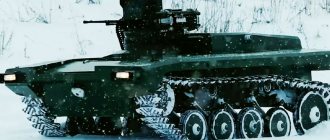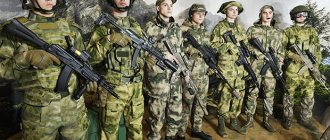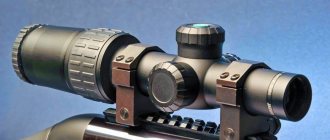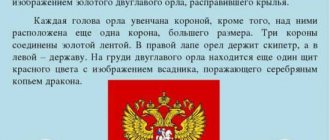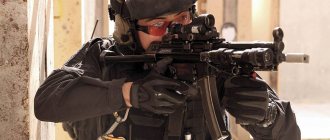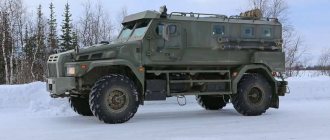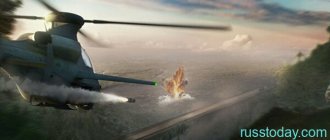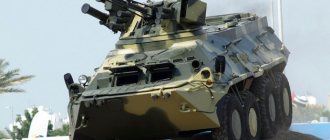Badges of special forces units of the Russian Guard
The badge of the National Guard of the Russian Federation “Excellence in service in special purpose military units (units), reconnaissance military units (units)” is made of tombak and is made in the form of a triangular shield with a rounded upper part and a wide white border.
The tip of the shield rests on a golden laurel wreath. At the top there are five golden ribbons. The field of the shield is maroon. At the top there is a heraldic sign - the emblem of the troops of the National Guard of the Russian Federation. At the bottom there is a round medallion with a maroon field and gold edging. In the field of the medallion there is a fist squeezing a horizontally placed machine gun, and behind it is the outline of a five-pointed star (the elements in the field of the medallion are golden in color). Along the border in the lower part there is a golden inscription: “EXCELLENT SERVICE”. Golden clasps are placed in the corners of the shield. On the reverse side of the badge there is a threaded pin with a nut for attaching to clothing. Dimensions of the badge: height – 42 mm, width – 32 mm. Approved
by order of the Federal Service of the National Guard Troops of the Russian Federation dated April 2, 2022 No. 111.
Requirements for candidates for service in the Russian Guard
As a rule, the age category of citizens wishing to serve under conscription in the National Guard is 18-27 years old, contract service is up to 31 years old. At the same time, applicants for contract service must already have military service behind them, preferably also in special forces (Airborne Forces, Marine Corps, Special Forces, Border Troops, etc.).
Citizens with experience or service (with a rank) in security forces and law enforcement agencies also have an advantage to serve in the Russian Guard. At the same time, police officers are recruited into the National Guard without passing qualification exams.
The call for other applicants to the Russian Guard includes the following events:
- Medical examination with assignment of military fitness category “A” (in some cases category “B” is allowed);
- Psychological testing (a candidate for service in an elite unit must have high levels of resistance to stressful situations and be adequate);
- Physical training (national guardsmen are subject to increased physical fitness requirements).
The gender of the candidate does not matter. At the same time, women can also apply for service in the National Guard, but only under the same conditions as men. As a rule, they are recruited for medical, photogrammetric, printing and communications positions. Also, women of the National Guard usually occupy positions of translators, psychologists, lawyers, video surveillance operators, incl. cooks
Despite this, female candidates for service in the elite units of the Russian Guard, along with men, undergo medical and psychological selection and pass physical training standards.
According to the current Russian legislation, a mixed recruitment of citizens is carried out into the National Guard, i.e. 80% of employees are contract soldiers, and 20% are conscripted employees during the 1st year.
How can a young man get to serve in the National Guard upon conscription? Let's consider the basic requirements for conscripts:
- Age category – 18-27 years;
- Availability of Russian citizenship - passport of a citizen of the Russian Federation, incl. official registration (registration) in one of the regions of Russia;
- Absence of any diseases or health problems (the draft commission must assign military fitness category “A”);
- Excellent indicators of moral and psychological state and stress resistance;
- High level of physical fitness.
If you have any health or mental health problems, you may not even be able to apply for military service in the Russian National Guard.
Physical physical fitness standards for candidates for the Russian National Guard using the point system:
| Exercises | Points | ||
| 53-72 | 73-88 | 89-100 | |
| 100m run | 14.8 s | 14.2 s | 13.6 s |
| Running 3000 m | 13 min 30 s | 12 min 45 s | 12 min |
| Pull-ups on the bar | 7 times | 9 times | 11 times |
Accordingly, if recruitment to an elite unit is carried out on a competitive basis, then candidates who score the maximum number of points in physical fitness have a greater chance of passing.
Special attention is also paid to the personal characteristics of applicants for service in the National Guard. Future special forces soldiers are required to have increased levels of:
- Self-control;
- Self-discipline;
- Responsibility;
- Performance.
An applicant for conscription for military service in the Russian Guard in 2022 must be courageous and decisive, but at the same time quite restrained, very attentive, and be able to clearly formulate and express his own thoughts, incl. obliged to adhere to public moral values.
Sleeve insignia of special purpose military units (units) by district of the Russian Guard
Sleeve insignia of special purpose military units (units) by district of the Russian Guard:
| for casual and dress uniforms | for field uniform |
The sleeve insignia is made in the form of a triangular shield with rounded sides, maroon in color, with an edging and a golden-colored dividing strip, dividing the field of the shield into the upper (head) and lower (main) parts. In the head part of the shield there are figures in the form of two guns placed crosswise, installed for the corresponding district* of the Russian Guard, silver in color. In the main part of the shield there is a fist squeezing a horizontally located machine gun (elements in the field of the shield are silver), and behind it is the outline of a five-pointed star of golden color. For sleeve insignia on the field uniform: the field color is olive, and the edging and figures in the shield are pistachio color.
—— *Note:
| for the Eastern District - two protazans; for the Volga District - two axes; for the Northwestern District - two swords; for the North Caucasus district - two daggers; | for the Siberian district - two arrows; for the Ural district - two halberds; for the Central District - two shestopers; for the Southern District - two checkers. |
The sleeve insignia was approved by Order No. 6 of the Federal Service of the National Guard Troops of the Russian Federation dated January 11, 2022.
Projects of sleeve insignia for special forces units of the Russian Guard 2022
Description of the sleeve insignia of special forces units of the Russian Guard, directly subordinate to the director of the Russian Guard:
The sleeve insignia is made in the form of a triangular shield of maroon color with rounded sides with a golden edging.
In the field of the shield there is a winged sword and a fist squeezing a machine gun placed horizontally (the elements in the field of the shield are silver) . For a sleeve badge on a field uniform: the field color is olive, and the edging and figures in the shield are pistachio color. For a sleeve badge on a black uniform: the field color is black, and the edging and figures in the shield are gray.
The front part of the emblem is a fist with the characteristic silhouette of an AKS-74U assault rifle. Immediately behind him is a sword with the tip down. The sword and fist are connected by wings into a single composition. The emblem itself is located in the center of the heraldic shield of maroon (dark red) color. But depending on the form of clothing, the sign can be embroidered with white, black or khaki threads.
The emblem was developed as part of the creation of heraldic symbols of the Russian Guard. In February 2022, it was presented to the director of the FSVNG, Viktor Zolotov, as one of the main options for special forces (as a sleeve badge on the right sleeve of the field, dress and everyday summer and winter uniforms of special forces soldiers of the Russian Guard).
Rationale for symbolism:
Previously, these heraldic symbols separately belonged to the special forces of the internal troops and the Ministry of Internal Affairs. The combination of two historical symbols of special forces into a single emblem shows that the command of the Russian Guard is making every effort to preserve traditions and recognize the merits of special forces units. A fist with a machine gun is a symbol of special forces units of the internal troops. In fighter slang it is called a “combat unit.” “Unit” symbolizes the ability of special forces to fight the enemy not only with firearms, but also in hand-to-hand combat. The symbol first appeared in the late 1980s with the special forces unit “Vityaz”. Later, the “combat unit” switched to the chevrons of other detachments and special forces groups of the internal troops. There was a “combat unit” even on the combat banners of special forces units of the explosives. Often on the chevrons of the units, the “combat unit” was complemented by another symbol of the special forces of the internal troops - the “maroon beret”. For some time, the “combat unit” was a symbol of reconnaissance battalions and detachments of internal troops, but later it was replaced by a stylized “wind rose.” The “winged sword” as the emblem of SOBR and OMON appeared only in 2012 during the reform of the Ministry of Internal Affairs. A sword with wings symbolizes speed of action in the fight against criminals and terrorists. But unlike the “combat unit” of the internal troops, the sword was not very popular among SOBR and OMON fighters. Before the appearance of the “sword,” the “unit” also served as a symbol of some special forces units of the Ministry of Internal Affairs.
| Sleeve insignia of special forces units of the Russian Guard by district for everyday uniforms | Sleeve insignia of special forces units of the Russian Guard by district for field uniforms |
These projects (2017) were not approved. Note: the images do not show projects of sleeve insignia for special forces units of the Southern District of the Russian Guard.
History of the Russian Guard and internal troops
Military service by conscription is considered an honorable duty for a man, and the branch of the military in which he will serve often matters only for the soldier’s personal pride. The state is equally important to the “elite” units - the Aerospace Forces, Airborne Forces, Navy, Marine Corps, and troops called upon to protect strategically important facilities within the state. Therefore, each branch of the military has a special purpose, which was developed based on the experience of previous generations and military science. This experience was paid for with considerable blood.
The state has always needed armed force not only to preserve its sovereignty - protection from external enemies, but also to protect internal order.
Russia is a very socially contradictory state, the history of which is replete with riots, uprisings, and separatist manifestations aimed at splitting internal unity. This trend can be traced throughout the history of the state.
For the first time, the prototype of the internal troops was created under Tsar Ivan IV the Terrible. He specially gathered for three months personally devoted young nobles who served to protect Moscow from mob riots. Subsequently, these functions were transferred to the guardsmen for a short period.
Peter I also left a mark on the history of the internal troops. It was under him that armed detachments of disabled people and recruits unsuitable for combat service began to be formed to maintain order in cities and fight rioters. But Alexander I can be considered the father and founder of the internal troops.
It was by the Highest Decree of Alexander I on March 27, 1811 that disparate military teams of disabled people, subordinate to the provincial authorities, were resubordinated to a single high command and acquired the status of military formations with absolutely specific goals - protecting the interests of the state from internal enemies.
The Internal Troops of the Russian Ministry of Internal Affairs were created in 1992 after the collapse of the USSR. The troops included all former formations of the Internal Troops of the USSR Ministry of Internal Affairs, stationed on the territory of the RSFSR. On April 5, 2016, Russian President Vladimir Putin signed a decree on the creation of the National Guard (Rosgvardia) on the basis of the Internal Troops of the Ministry of Internal Affairs of Russia.
